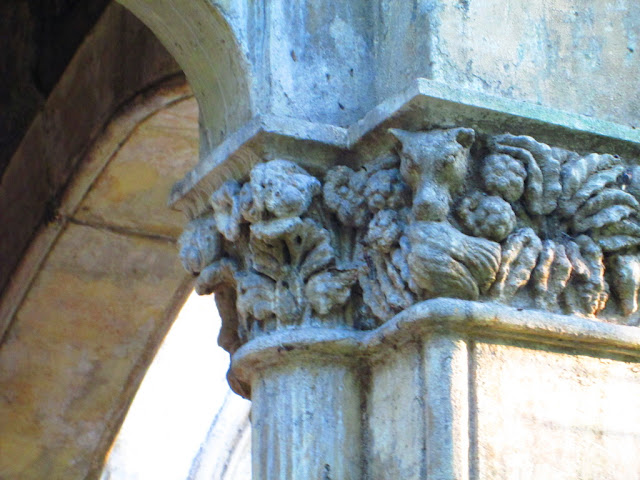Walking through Panjrapole- A Photo Essay
"Where do you live in Chembur?"
"Panjrapole"
"Err, where is that?"
"You know, where the Freeway begins?"
"Ah that. I never knew"
(Excerpt from many conversations I have had with friends who are residents of Chembur)
Last year in June, I took up admission for an MA program at the Tata Institute of Social Sciences, Deonar. It made sense to move into a house closer to college. So I chose to live on Din Quarry Road, in Panjrapole, a seven minute walk to the old campus. But I live at the foothills, and I take a detour while the road continues to climb right to the top, going all the way above the tunnel of the Freeway. Last evening, I skipped my detour and walked up the slope, as high as the road would take me.
Panjrapole, which loosely translated means an enclosed yard, typically built to care for cattle, birds, and other small animals can be found all over India. The Bombay Panjrapole at Bhuleshwar was established in 1934 following the Dog Riots of 1932 is an institution which needs to be seen to believed. An infirmary that takes care of dogs, donkeys, pigeons, parrots, cows right in the middle of a bazaar is one of the more fascinating sites of the city. One of their five branches is located in Chembur where I now live. I have wondered countless times about the location of the shed for cows in the surrounding neighbourhood. But I could never find it. Today evening, I set out on a whim along the road that no rickshawallah wants to take in search of the elusive Panjrapole of Chembur. The entire locality beginning from Shivaji Chowk stretching all the way up till the eyes can see is classified as Panjrapole.
A MHADA colony, a few SRA buildings stand amid what can be classified as pucca and kuccha dwellings which together the BMC classifies as slums or zhopadpatti. Higher up the slope as is the norm, lie the more recent dwellings entirely made of asbestos sheet/tin sheets (patra). As the road continues upwards, the contrasts of the city are evident. Leaving behind the more affluent parts of Chembur, the road rises, almost paradoxically into one of Bombay's most poor neighbourhoods. My experience with these neighbourhoods is not new, in fact I have learnt to identify them by their markers - small businesses.
Small businesses, especially street vendors selling everything from freshwater fish, snacks, dried fish, small cutlery items, toys, (not so fresh) vegetables and fruits are symbols of these neighbourhoods. You can walk around Bhagat Singh Nagar, Malad or Nehru Nagar, Kurla and you are most likely to meet the same assortment each time. In addition to this, small hole in the wall barber shops, tea stalls, meat stalls - most selling broiler chicken except for the odd mutton shop, which will not flaunt a line of customers.
Symbolism in form of flags put up at chowks and public gathering spaces along with the presence of various religious structures indicates a cosmopolitan population. However, prominently seen are the RPI Flags, buddhist prayer structures which indicate a sizeable Buddhist population in the area. Then of course there is the accumulated garbage, choked - swamp like sewage ponds and the ubiquitous black pigs, children defecating in the open spaces and playing a game of cricket not far away.
To my right, almost as if in the erstwhile valley runs the Eastern Freeway. Many locals just simply stand by the boundary wall and look down at the fast cars that zoom below. Most of them take pride in the freeway and told me excitedly about how a scene from Ok, Jaanu was shot here. However, most trudge down the slope all the way to Govandi station to take the crowded local to work everyday. Apart from a couple of limited buses, there exists no affordable option to experience the freeway. Virtually everyone needs to climb down for ration, for the hospital, for the school. Most of our canteen and facility management staff lives here. It's a tough life, they tell me.
 |
| Just a happy goat |
 | ||
Life Under the Freeway
|
 | ||
| The Joyride, this wiry man heaves and pushes the heavy duty metal boat with 10 shrieking pirates inside. |
 |
| Just some hen hanging out over the eastern freeway #OnTheEdge |
 |
| Dried Fish, substitute for fresh seafood |
 |
| Numerous Flag Posts like these can be found across Panjrapole |
 |
| Panjrapole - At Last |
Finally, on my amble across Panjrapole I met three children from a nearby school. I asked them if they knew about where I could find cows. And they took me here. The small branch of Bombay Panjrapole. At last. I couldn't talk much to the locals about it but apparently it has been around since 'many' years. Though you can't see the cattle, MumbaiPaused has captured them well in this photo. The pressures of real estate would have shrunken the size of this pol.
Panjrapole to me is yet another neighbourhood of Bombay that keeps the contrasts of the city alive. The workers from Panjrapole keep the city well oiled and running. They are neglected and ignored but they continue to persist and hardly perish.
|





Comments